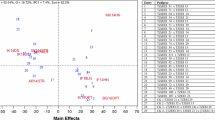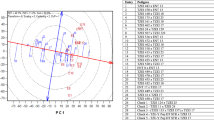Abstract
Two major constraints militating against the achievement of food security in West Africa (WA) are recurrent drought and poor soil fertility. Seventeen early maturing maize inbreds from IITA and CIMMYT were used as parents to produce 136 diallel crosses which were evaluated along with four checks in contrasting environments at four locations for 2 year in Nigeria. The objectives of the study were to (i) examine the combining ability of the lines under drought, low soil nitrogen (low N), optimal and across environments; (ii) classify the inbreds into heterotic groups using the specific combining ability (SCA) effects of grain yield, heterotic group’s specific and general combining ability (HSGCA), the heterotic grouping based on general combining ability (GCA) of multiple traits (HGCAMT) and the molecular-based genetic distance methods; (iii) compare the efficiencies of the four heterotic grouping methods in classifying the inbreds and identifying the best testers; and (iv) examine the performance of the inbreds in hybrid combinations across environments. Sum of squares for GCA of inbreds for grain yield and other measured traits were larger than those of the SCA in all environments. The relative importance of GCA to SCA effects for grain yield and other traits increased from stress to nonstress environments with the additive genetic effects accounting for the major portion of the total genetic variation under all research environments. The HSGCA method classified the lines into three groups and was the most efficient because it had the highest breeding efficiency (40 %) in the test environments followed by the HGCAMT, SNP marker-based and the SCA effects of grain yield methods. Inbred TZEI 19 was identified as the best tester across research environments based on HSGCA method. Hybrids ENT 11 × TZEI 19 and TZEI 1 × TZEI 19 were the most outstanding and should be tested extensively in on-farm trials and commercialized.


Similar content being viewed by others
References
Akinwale RO, Badu-Apraku B, Fakorede MAB, Vroh-Bi I (2014) Heterotic grouping of tropical early-maturing maize inbred lines based on combining ability in Striga-infested and Striga-free environments and the use of SSR markers for genotyping. Field Crops Res 156:48–62
Badu-Apraku B, Oyekunle M (2012) Genetic analysis of grain yield and other traits of extra-early yellow maize inbreds and hybrid performance under contrasting environments. Field Crops Res 129:99–110
Badu-Apraku B, Lum AF, Akinwale RO, Oyekunle M (2011a) Biplot analysis of diallel crosses of early maturing tropical yellow maize inbreds in stress and nonstress environments. Crop Sci 51:173–188. doi:10.2135/cropsci2010.06.0366
Badu-Apraku B, Oyekunle M, Akinwale RO, Lum AF (2011b) Combining ability of early-maturing white maize inbreds under stress and nonstress environments. Agron J 103:544–557
Badu-Apraku B, Fakorede Menkir A, Ajala MAB, Ajala SO, Ellis-Jones J (2012) Building partnerships and encouraging innovation for sustainable maize production: the West and Central Africa Collaborative Maize Research Network, achievements and impact. IITA, Ibadan
Badu-Apraku B, Oyekunle M, Fakorede MAB, Vroh I, Akinwale RO, Aderounmu M (2013) Combining ability, heterotic patterns and genetic diversity of extra-early yellow inbreds under contrasting environments. Euphytica 192:413–433
Badu-Apraku B, Gedil M, Annor B, Talabi AO, Oyekunle M, Akinwale RO, Fakorede MAB, Fasanmade TY, Akaogu IC (2015). Genetics of tolerance to drought and low soil nitrogen in IITA and CIMMYT early yellow maize inbreds. J Agron Crop Sci (unpublished)
Baker RJ (1978) Issues in diallel analysis. Crop Sci 18:535–536
Balestre M, Von Pinho RG, Souza JC, Lima JL (2008) Comparison of maize similarity and dissimilarity genetic coefficients based on microsatellite markers. Genet Mol Res 7:695–705
Bänziger M, Lafitte HR (1997) Efficiency of secondary traits for improving maize for low-nitrogen target environments. Crop Sci 37:1110–1117
Bänziger M, Betran FJ, Laffite HR (1997) Efficiency of high-nitrogen selection environments for improving maize for low-nitrogen target environments. Crop Sci 37:1103–1109
Banziger M, Edmeades GO, Beck D, Bellon M (2000) Breeding for drought and nitrogen stress tolerance in maize. From theory to practice. CIMMYT, Mexico
Beck D L, Betrán FJ, Banzigiger M, Edmeades GO, Ribaut JM, Willcox M, Vasal SK, Ortega C A (1996) Progress in developing drought and low soil nitrogen tolerance in maize. In: Proceedings of the 51st annual corn and sorghum research conference, Chicago, 10–11 Dec 1996. ASTA, Washington, pp. 85–111
Below FE, Brandau PS, Lambert RJ Teyker RH (1997) Combining ability for N use efficiency in maize. In: Edmeades GO, Banziger M, Mickeisen HR Pena-Valdivia, CB (eds) Drought and low-N tolerant maize: Proceedings of a symposium, Elbatan, Mexico, 25–29 March 1996. CIMMYT, Mexico, D.F. pp 316–319
Benchimol LL, De Souza CL, Garcia AAF, Kono PMS, Mangolin CA, Barbosa AMM, Coelho ASG, De Souza AP (2008) Genetic diversity in tropical maize inbred lines: heterotic group assignment and hybrid performance determined by RFLP markers. Plant Breed 119:491–496
Betrán JF, Ribaut JM, Beck DL, Gonzalez de Leon D (2003) Genetic analysis of inbred and hybrid grain yield under stress and non-stress environments in tropical maize. Crop Sci 43:807–817
Bradbury PJ, Zhang Z, Kroon DE, Casstevens TM, Ramdoss Y, Buckler ES (2007) TASSEL: software for association mapping of complex traits in diverse samples. Bioinformatics 23:2633–2635
Bremner JM, Mulvaney CS (1982) Nitrogen-total. p. 595–624. In: Page AL et al. (ed) Methods of soil analysis, part 2, 2nd ed. Agron. Monogr. 9. ASA and SSSA, Madison
Crossa J (1990) Statistical analyses of multilocation trials. Adv Agron 44:55–85
Edmeades GO, Bolanõs J, Lafitte HR (1992) Progress in breeding for drought tolerance in maize. In: Wilkinson D (ed) Proceedings of the 47th annual corn and sorghum industrial research conference. ASTA, Washington, DC, pp 93–111
Elshire RJ, Glaubitz JC, Sun Q, Poland JA, Kawamoto K (2011) A robust, simple genotyping-by-sequencing (GBS) approach for high diversity species. PLoS One 6(5):e19379
Fan XM, Chen HM, Tan J, Xu CX, Zhang YM, Huang YX, Kang MS (2008) A new maize heterotic pattern between temperate and tropical germplasms. Agron J 100:917–923
Fan XM, Zhang YM, Yao WH, Chen HM, Tan J, Xu CX, Han XL, Luo LM, Kang MS (2009) Classifying maize inbred lines into heterotic groups using a factorial mating design. Agron J 101:106–112
Gauch HG, Zobel RW (1988) Predictive and postdictive success of statistical analyses of yield trials. Theor Appl Genet 76:1–10
Griffing B (1956) Concept of general and specific combining ability in relation to diallel crossing systems. Aust J Biol Sci 9:463–493
Gutierrez-Gaitan MA, Cortez-Mendoza H, Wathika EN, Gardner CO, Oyervides-Garcia M, Hallauer AR, Darrah LL (1986) Test cross evaluation of Mexican maize populations. Crop Sci 26:99–104
Hall AJ, Villela F, Trapani N, Chimenti C (1982) The effect of water stress and genotype on the dynamics of pollen-shedding and silking in maize. Field Crops Res 5:349–363
Hamblin MT, Warburton ML, Buckler ES (2007) Empirical comparison of Simple Sequence Repeats and single nucleotide polymorphisms in assessment of maize diversity and relatedness. PLoS One 2:e1367
Hung HY, Holland JB (2012) Diallel analysis of resistance to fusarium ear rot and fumonium contamination in maize. Crop Sci. doi:10.2135/cropsci2012.03.0154
Ifie BE (2013) Genetic analysis of Striga resistance and low soil nitrogen tolerance in early maturing maize (Zea mays L.) inbred lines. PhD Thesis, University of Ghana Legon. West Africa Centre for Crop Improvement/School of Agriculture/College of Agriculture and Consumer Sciences
Ifie BE, Badu-Apraku B, Gracen V, Danquah EY (2015) Genetic analysis of grain yield of IITA and CIMMYT early-maturing maize inbreds under Striga-infested and low-soil nitrogen environments. Crop Sci 55:610–623. doi:10.2135/cropsci2014.07.0470
Kling JG, Oikeh SO, Akintoye HA, Heuberger HT, Horst WJ (1997) Potential for developing nitrogen-use efficient maize for low input agricultural systems in the moist savannas of Africa. In: Edmeades GO, Bänziger MH, Mickelson R, Peña-Valdivia CB (eds) Proceedings of an international symposium on developing drought- and N-efficient Maize. Mexico, CIMMYT, pp 490–501
Lanza LLB, de Souza Jr CL, Ottoboni LMM, Vieira MLC, de Souza AP (1997) Genetic distance of inbred lines and prediction of maize singlecross performance using RAPD markers. Theor Appl Genet 94:1023–1030. doi:10.1007/s001220050510
Liu K, Muse SV (2005) Power marker: integrated analysis environment for genetic marker data. Bioinformatics 21:2128–2129
Makumbi D, Betrán FJ, Bänziger M, Ribaut J (2011) Combining ability, heterosis and genetic diversity in tropical maize (Zea mays L.) under stress and non-stress conditions. Euphytica 180:143–162
Menkir A, Adetimirin VO, Yallou CG, Gedil M (2010) Relationship of genetic diversity of inbred lines with different reactions to Striga hermonthica (Del.) Benth and the performance of their crosses. Crop Sci 50:602–611
Meseka SK, Menkir A, Ibrahim AES, Ajala SO (2006) Genetic analysis of performance of maize inbred lines selected for tolerance to drought under low nitrogen. Maydica 51:487–495
Moss GI, Downey LA (1971) Influence of drought on female gametophyte development in corn (Zea mays L.) and subsequent grain yield. Crop Sci 11:368–371
Rogers JS (1972) Measures of genetic similarity and genetic distance. Studies in genetics VII. Univ Tex Publ 7213:145–153
Sadeghi SM, Samizadeh H, Amiri E, Ashouri M (2011) Additive main effects and multiplicative interactions (AMMI) analysis of dry leaf yield in tobacco hybrids across environments. Afr J Biotech 10:4358–4364
Saghai-Maroof MA, Soliman KM, Jorgenson R, Allward RW (1984) Ribosomal DNA spacer length polymorphisms in barley: Mendelian inheritance, chromosomal location and population dynamics. Proceedings of National Academy of Science 81:8014–8018
SAS Institute Inc. (2011) Base SAS® 9.3 Procedures Guide. Cary, NC: SAS Institute Inc.
Schnable PS, Ware D, Fulton RS, Stein JC, Wei F et al (2009) The B73 maize genome: complexity, diversity, and dynamics. Science 326(5956):1112–1115
Semagn K, Magorokosho C, Vivek BS, Makumbi D, Beyene Y, Mugo S, Prasanna BM, Warburton ML (2012) Molecular characterization of diverse CIMMYT maize inbred lines from eastern and southern Africa using single nucleotide polymorphic markers. BMC Genom 13:113
Semagn K, Babu R, Hearne S, Olsen M (2014) Single nucleotide polymorphism genotyping using Kompetitive Allele Specific PCR (KASP): overview of the technology and its application in crop improvement. Mol Breed 33:1–14
Shieh GJ, Thseng FS (2006) Genetic diversity of Tainan white maize inbred lines and prediction of single cross hybrid performance using RAPD markers. Euphytica 124:307–313. doi:10.1023/A:1015753820623
Suwarno WB, Pixley KV, Palacios-Rojas N, Kaeppler SM, Babu R (2014) Formation of heterotic groups and understanding genetic effects in a provitamin A biofortified maize breeding program. Crop Sci 54:14–24
Thomas H, Howarth CJ (2000) Five ways to stay green. J Exp Bot 51:329–337
Vasal SK, Srinivasan G, Pandey S, González F, Crossa J, Beck DL (1993) Heterosis and combining ability of CIMMYT’s quality protein maize germplasm: I. Lowland tropical. Crop Sci 33:46–51
Yan W (2001) GGE biplot: a Windows application for graphical analysis of multi-environment trial data and other types of two-way data. Agron J 93:1111–1118
Zhang Y, Kang MS, Lamkey KR (2005) DIALLEL-SAS: a comprehensive program for Griffing’s and Gardner–Eberthart analyses. Agron J 97:1097–1106
Zobel RW, Wright MJ, Gauch HG (1988) Statistical analysis of a yield trial. Agron J 80:388–393
Author information
Authors and Affiliations
Corresponding author
Electronic supplementary material
Below is the link to the electronic supplementary material.
Rights and permissions
About this article
Cite this article
Badu-Apraku, B., Fakorede, M.A.B., Gedil, M. et al. Heterotic responses among crosses of IITA and CIMMYT early white maize inbred lines under multiple stress environments. Euphytica 206, 245–262 (2015). https://doi.org/10.1007/s10681-015-1506-0
Received:
Accepted:
Published:
Issue Date:
DOI: https://doi.org/10.1007/s10681-015-1506-0




